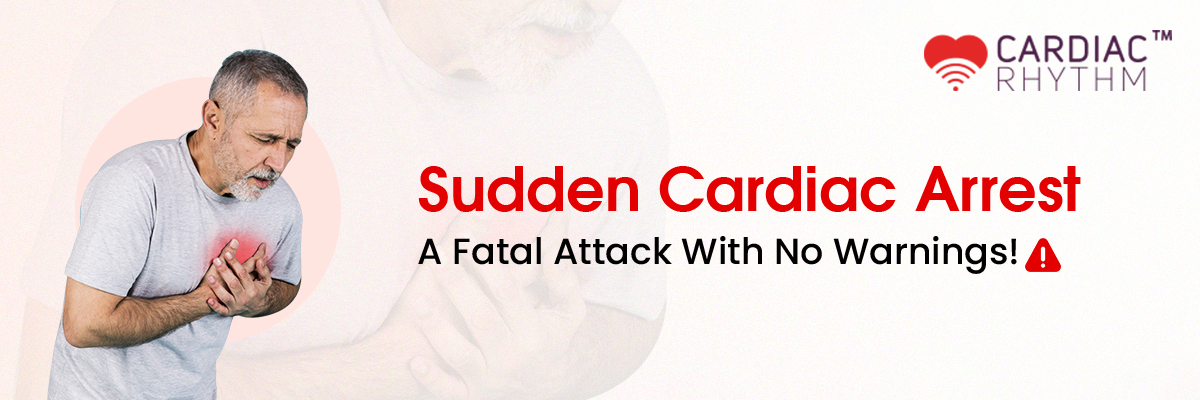

call us:1800 5999 5999
+91 72 0005 0005
Sudden Cardiac Arrest – A Fatal Attack With No Warnings
Posted on April 26, 2021
Sudden Cardiac Arrest (SCA), as the name suggests, leads to unexpected failure of the heart and is oftentimes fatal. It requires immediate medical attention and if the patient does not receive treatment immediately it can result in death within a matter of minutes. This is one of the characteristic differences between a heart attack and SCA. The casualties are higher as the symptoms only appear a few moments before the life-threatening episode, unlike a heart attack where a host of symptoms are present at least a few weeks before the event.What is more perplexing about this attack is that it can strike people of any age, race, gender and even physically active individuals such as athletes.

Another difference that adds to the danger is SCA renders a person unconscious and the heartbeat comes to a standstill. During a heart attack, the individual is conscious and can communicate the symptoms making it easier to rush them to an emergency room. According to Sudden Cardiac Arrest Foundation, a heart attack may be compared to a plumbing problem in the heart, while a Sudden Cardiac Arrest may be compared to an electrical problem in the heart which is why it can prove to be more fatal than the former.
Although understanding the definite set of common factors that come together to trigger the attack are still being studied, so far in most cases of SCA, it was found that patients had a history of heart disease. They experienced fainting, dizziness and palpitations, symptoms that were ignored due to a lack of awareness of their connection to heart problems. Chest pain, shortness of breath and fainting during activities that demand high energy such as sports. Blood pumping during each heartbeat was found to be 40% lower in SCA patients. Also, comorbid conditions related to an unhealthy lifestyle such as high blood pressure, diabetes, obesity and high cholesterol were also eminent in findings related to the causes.
Survivors and people susceptible to this fatal attack have hope in the form of implantable cardioverter defibrillators (ICDs) and wearable cardioverter defibrillators (WCDs). These implantable devices can detect any irregularities in the heartbeat and respond immediately to even the slightest threat, which in the event of an SCA is detrimental for survival. These devices are built to detect the abnormality of your heart rhythm and administer a high-energy or low-energy shock accordingly. Usually, in the event of an attack, it is strictly suggested that immediate cardiopulmonary resuscitation (CPR) or the use of an automated external defibrillator (AED) is necessary for any chance of recovery.
In 2018 SCA was reported as the leading cause of death in the U.S. affecting more than 356,000 people each year and at least 500 of these casualties were athletes. SCA deaths in men overtook the figures of casualties attributed to several other individual causes of death such as lung cancer, accidents, chronic lower respiratory disease, cerebrovascular disease, diabetes mellitus, prostate cancer, and colorectal cancer. People diagnosed with sleep apnea, chronic kidney disease, diabetes, high blood pressure and high cholesterol were also found to be at a higher risk of SCA.
This is the function performed by implantable devices in survivors and patients whose conditions were diagnosed on time. ICD’s and WCDs are designed to track heart activity and send reports to your caregiver. The data acquired through these heart monitoring devices is studied by a caregiver to ascertain the type of arrhythmia the patient is most at risk of having. Then the device is updated and altered to function based on the analysis of the patient’s heart monitoring data and is customize to deliver shocks based on the type of arrhythmia that is most likely to occur.
A host of cardiac monitoring options available today are built on reliable technology with precise detection capabilities ready to be deployed in treatment plans. Artificial Intelligence methods have proved to be highly effective in meeting the critical detection needs of cardiovascular conditions such as SCA. The slightest change in a person’s heart rhythm is captured, reported and analysed to customise and tailor the workings of the device in the event of any cardiac abnormalities.
Cardiac monitoring services at Cardiac Rhythm are rendered by IBHRE certified clinicians and an experienced team of project managers, MD cardiologists, consultants, data managers and bio-staisticians. Monitoring services for Implantable loop recorder(ILR), pacemakers, ICD and heart failure are becoming increasingly essential in providing effective care and are proving to be the best safety measures in patients with serious cardiovascular complications.
Caregivers, patients and providers must be informed of the precautions to be taken during medical procedures which involve electric and magnetic devices. Patients must take the time to educate themselves on how to incorporate their routine activities and other gadgets safely and avoid any damage or interference with their ICD and WCD devices.
In most cases these health monitoring devices allow the patient to revert to their normal routines and even take part in high-intensity activities aside from contact sports which can damage the device. In fact, survivors need to return to their usual activity after a time of rest and patients are encouraged to live life normally engaging in activities that build physical and mental health for better prognosis post the attack and implant surgery. If the patients previously led a sedentary lifestyle or indulged in addictive behaviours it is important to replace them with healthier alternatives. The risks for any health problems can be reduced by making healthier lifestyle choices.
Tags: Cardiac Arrest, Cardiac Monitoring Services, Heart Monitoring, Implantable Devices